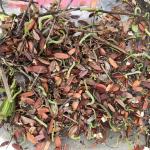Buds are pushing out of elongation and even into roughneck at some locations. This is especially so for the newer hybrids and newer beds. The next few days look promising for a break from frost protection, but monitoring continues.
For fertilizer planning, consider the variety, previous summer tissue tests and historic bog response. The goal is to provide enough nitrogen to produce a stand of uprights with optimal density and length that will produce good quality fruit. A thin, stunted stand will not support a large crop. If the canopy is too dense or has too many long runners, pollinators cannot work as well, and leads to increased shading and relative humidity which favors fruit rot fungal infections. If you are using slow or controlled release fertilizers, 50-100% of your N dose goes out now (if you do not use 100%, apply the balance at set). Fast-acting soluble fertilizer would be about 20% at roughneck to hook. Bogs that held late water floods can typically skip the first N dose.
Monika Shuler reports sweeping 25-50 counts of weevil in some locations - starting to see some feeding damage. Green spanworm more abundant than in years past (see photo below c/o Marty Sylvia). She reports counts of 25+ in some sweeps. These insects should not be ignored as they can cause some significant damage - especially at these levels. Only a few false armyworm here and there and no blackheaded fireworm or spag yet. She has also seen some left over damage from scale last year. Erika from Ocean Spray also reports that cranberry weevil and green spanworm are out and above threshold at several locations. She has seen just a few gypsy moth larvae. Some bogs have no or few insects, so be sure to monitor your own bogs.
If you are using pheromone traps for Spag, BHF and/or girdler, they should be set out by June 1. Use 1 trap per 10 acres. Place on the upwind side of the bog. Traps should be checked weekly; write down the number of moths captured. The bait should be changed every 3 weeks. Use of pheromone traps will help you time your insecticide sprays for these pests. Supplies can be ordered on-line from IPM supply houses; local ag suppliers may also have traps and lures.
As you make plans for upcoming fruit rot applications, in compliance with your handler and fungicide label recommendations, incorporate the fungicide resistance management strategies such as 1) alternating or mixing of fungicides with different modes of action. Use FRAC (Fungicide Resistance Action Committee) codes on the labels to determine the mode of action. Fungicides with the same FRAC codes have similar modes of action. 2) Follow ALL label instructions, including application interval, recommended rates, water-holding time and pre-harvest interval.
If you are considering broad-spectrum fungicides such as Chlorothalonils (e.g., Bravo Weather Stik and Bravo Ultrex) and Mancozebs (e.g., Manzate Max, Dithane M-45) as part of fungicide regimes, please use them early in “the possible infection period” or “disease development phase” (when the maximum number of flowers are open: Early to mid-bloom). Do not apply more than two applications of Group 3 and Group 11 fungicides (e.g., Proline, QuadrisTop, Indar and Abound) due to resistance concerns. Copper fungicides (e.g., Kocide 3000, Badge SC, Champ, Mastercop), if chosen, should be applied later, starting from late bloom.
